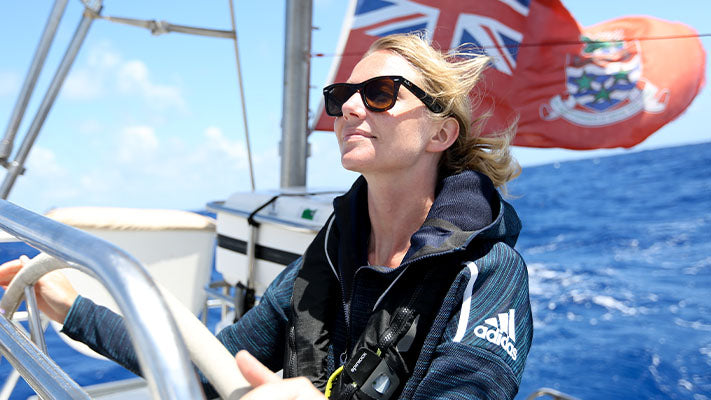Ask British eco activist Emily Penn where she was headed just over a decade ago, and she'll say straight to an architecture firm in Australia. But when Penn decided to hitch a ride Down Under on a cross-Atlantic powerboat called Earthrace, life took a surprising turn. "I showed up for a trial weekend on the boat in the UK—and I didn’t go home for another 920 days," she admits with a laugh. While sailing across the vast expanse of ocean, the crew stopped each morning for a quick dip over the side of the boat. There, Penn spotted more than just marine life. "I remember seeing a toothbrush, a cigarette lighter, a bottle top—and we were 820 miles from land. That's when I started asking questions."
These days, Penn is the co-founder of eXXpedition, a pioneering all-female organization on a mission to study the effects of plastic and toxic pollution in our oceans—as well as its causes and solutions. "There are over 5 trillion pieces of micro plastics floating on the surface of the sea," Penn explains. Some start as larger objects, such as plastic bottles, and get broken down by UV, wind, or waves before ending up in accumulation zones—areas in the middle of our oceans where, as a result of currents, "all the plastic ends up." Others are as tiny as the microbeads in face wash or hand soap. Regardless of the starting point, says Penn, many ultimately end up on the bottom of the ocean, where they are too deep to be recovered, or in the belly of seafood like fish before eventually making their way into the human food chain.
The problem plays out most visibly in the world's oceans, but Penn is quick to point out that it starts on dry land. "Globally, only 9% of the plastic we use gets recycled," she explains. "The reason is that there are hundreds of types of plastics made from different materials, which makes them complicated or impossible to recycle. A toothbrush, for instance, is made of 4 kinds of plastic—the bristles, the glue, the handle and so on."
Beauty products, of course, are a particularly large source of single-use plastics. By exploring new uses for biodegradable, reusable, or refillable packaging, "brands like Westman Atelier are working on it," says Penn. Yet the issue remains complex. Which brings Penn back to that toothbrush drifting past her boat eight years ago. "It’s a small action [of tossing something into the trash] that creates the problem," says Penn. "But it's also small actions that are going to solve it. We don't need everyone to do everything perfectly. We just need everyone to do something, or a few small things."
That's where, in addition to taking stock of your own plastic consumption and output, purchasing power matters. Here, just in time for Earth Day, Penn names her favorite simple ways to streamline your recycling bin—and six brands that make it easier.
Package-Free Toiletries
“Shampoo and conditioner once accounted for a lot of my plastic consumption. My top pick for reducing your impact at home is something I call “naked toiletries.” By that I mean, go with an old-fashioned soap bar, instead of using one in a liquid format with plastic packaging. Try a toothpaste in tablet form that activates with water. Look for solid body cream. A global beauty brand called Lush does these kinds of personal items well, and there are more great companies out there every day.”
Soda Stream
“A Soda Stream turns tap water into sparkling water. You take a glass bottle, fill it up, and the machine carbonates it. I’m quite partial to a gin and tonic so I love that you can add syrup, too. The idea here is to eliminate more plastic bottles, simply because you want something that's inside them.”
Plaine Beauty Oil
“I always say, ‘think about the end life of a product before the first life.’ Looking for refillable and recyclable beauty products is a start. Eliminating plastic entirely from that equation is even better. Plaine makes face creams, shampoos, and even hand sanitizers that come in stainless steel containers. When you’re done, you send back your container, it gets refilled, and sent back to you. On a larger scale, companies like Loop work with supermarkets, drug stores, and brands like Hagaan Daaz to create a similar plastic-free system. You can find a list of their partners on the Loop website.”
Finisterre Wetsuits
“Wetsuits are traditionally made from neoprene plastic. Finisterre is a sustainability minded company that uses cleaner sources, such as natural rubber, for surfing and swimming.”
Bambino Mio Reusable Diapers
“Being a new mom, diapers have become something to contend with on a daily basis. Bambino Mio does great reusable ones. You’ve already got laundry to do, so what’s a few extra diapers? Wipes are another plastic source. I use bamboo ones and keep a little water bottle alongside the changing table, or you can put them in a container that makes them damp and just pop them out.”
Rothy's Shoes
“Rothy's makes shoes out of single-use plastic that would otherwise end up in the ocean and there are enough styles and colors to find anything you could want. But it’s worth mentioning that this is still a linear process. There are some companies, like Nicholas Kirkwood, that are currently experimenting with biodegradable shoes. Adidas came up with a model made from one type of plastic, so that it could be recycled. That kind of innovation is really exciting."
***
Learn more about Exxpedition's mission here or visit @exxpedition for a closer look. Want to know more about Westman Atelier's sustainability efforts and conversion to recyclable packaging? We're glad you asked.
















